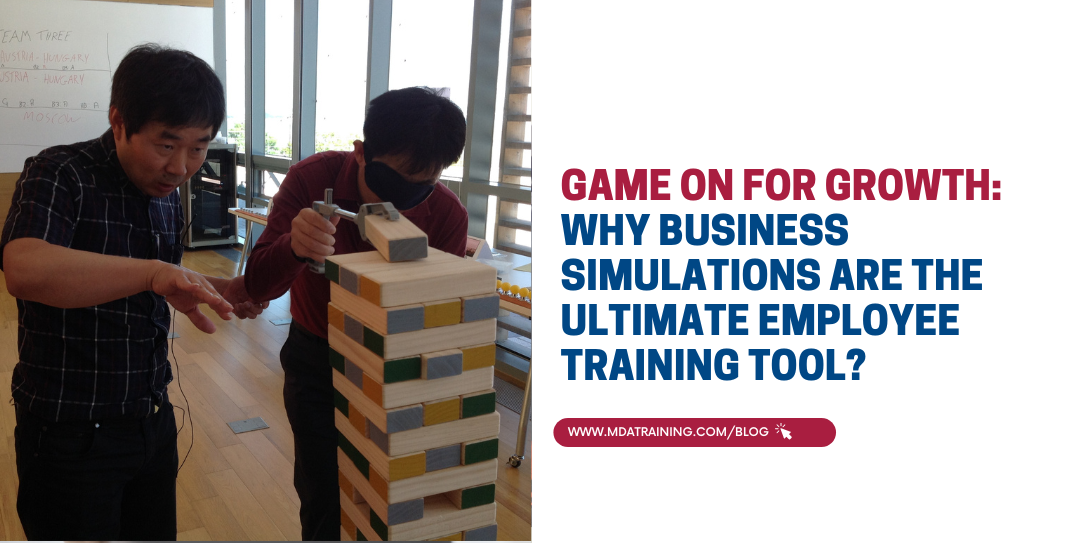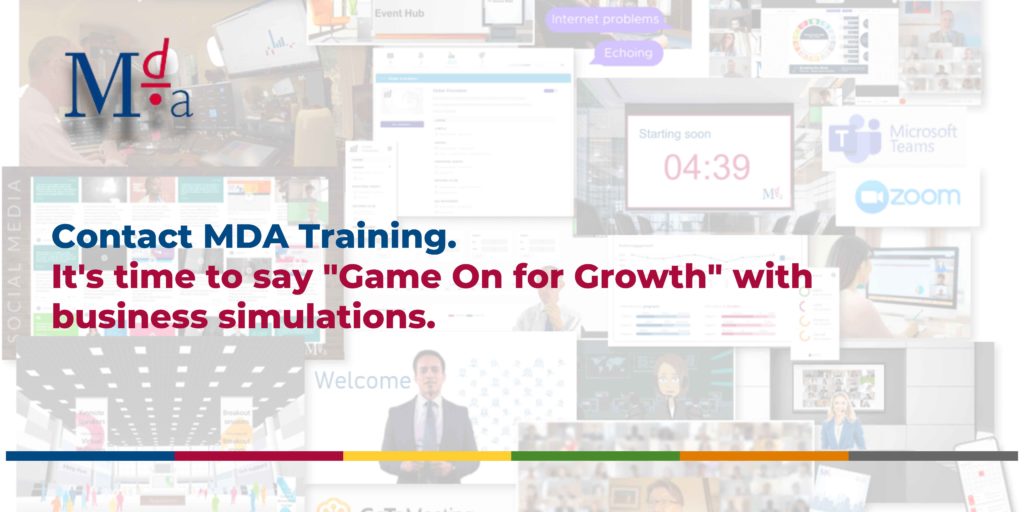In the ever-evolving landscape of business, the importance of employee training cannot be overstated. Companies that invest in their employees’ development consistently outperform their competitors. One innovative and highly effective method gaining traction in recent years is the use of business simulations. These simulations offer a dynamic and engaging way to train employees, providing them with practical experience in decision-making and problem-solving. In this blog, we will explore why business simulations are becoming the ultimate employee training tool.
The Need for Effective Employee Training
Before delving into the world of business simulations, let’s first understand why employee training is crucial for any organisation:
- Skill Development: Employees need to constantly acquire new skills to adapt to changing industry trends and technologies.
- Increased Productivity: Well-trained employees are more efficient and productive, leading to improved company performance.
- Retention and Engagement: Offering opportunities for growth and development boosts employee satisfaction and reduces turnover.
- Risk Mitigation: Properly trained employees are less likely to make costly mistakes that could harm the company’s reputation.
Now that we understand the importance of employee training, let’s explore why business simulations are emerging as the go-to solution:
Real-World Experience
One of the most significant advantages of business simulations is their ability to provide participants with a taste of real-world experience within a controlled and safe environment. This aspect of business simulations is fundamental to their effectiveness as an employee training tool. Let’s delve deeper into why real-world experience matters in the context of employee development:
- Learning by Doing: Traditional training methods often rely on passive learning, where employees are presented with information through lectures or presentations. While this can be informative, it lacks the active engagement that comes with hands-on experience. Business simulations enable participants to take an active role, allowing them to apply theoretical knowledge in practical scenarios.
- Safe Environment: Making mistakes is an integral part of the learning process, especially in complex business environments. Business simulations provide a risk-free setting where employees can experiment with different strategies and tactics. When they encounter setbacks or failures, these experiences become valuable lessons rather than costly errors for the organisation.
- Complex Decision-Making: In the real world, business decisions often have multifaceted consequences that may not be immediately apparent. Simulations mimic this complexity by presenting participants with intricate scenarios where their choices impact various aspects of the simulated business. This complexity encourages critical thinking and the development of decision-making skills.
- Confidence Building: Confidence is a crucial attribute in any professional setting. Business simulations allow employees to gain confidence in their abilities by successfully navigating simulated challenges. This newfound confidence can translate into better performance and leadership skills in their actual job roles.
- Bridging Theory and Practice: Often, employees learn theoretical concepts during training but struggle to apply them effectively in their daily work. Business simulations bridge the gap between theory and practice by giving participants the opportunity to implement what they’ve learned in a practical setting. This application of knowledge enhances understanding and retention.
- Adapting to Change: In today’s rapidly evolving business environment, adaptability is key. Business simulations can simulate market fluctuations, industry disruptions, and other dynamic factors, helping employees adapt to change and develop resilience in the face of uncertainty.
- Real-time Feedback: Many business simulations offer real-time feedback, allowing participants to see the immediate consequences of their decisions. This feedback loop is invaluable for learning, as it helps employees connect their actions with outcomes and adjust their strategies accordingly.
- Cross-Functional Learning: Business simulations often involve multiple facets of an organisation, requiring participants to collaborate across departments and functions. This cross-functional learning fosters a holistic understanding of how different parts of the business work together to achieve common goals.
Decision-Making Practice
In business simulations, decision-making practice takes centre stage. Participants are presented with scenarios that require them to make strategic choices, just as they would in their actual job roles. Here’s why decision-making practice is so valuable:
- Realistic Scenarios: Business simulations mirror real-world situations, allowing participants to confront decisions that mimic those faced in their roles. This provides a high degree of relevance and practicality.
- Risk-Free Environment: Unlike in the real world, where poor decisions can have severe consequences, simulations offer a risk-free space to experiment with different strategies. This empowers employees to take calculated risks and learn from the outcomes.
- Iterative Learning: Business simulations often involve multiple rounds or iterations. Participants can refine their decision-making approaches based on past experiences and feedback, resulting in a continuous learning cycle.
- Complex Decision-Making: Simulations introduce complexity by incorporating various factors and variables that affect decision outcomes. This encourages critical thinking and the development of decision-making skills that can be applied to multifaceted real-world scenarios.
Collaboration and Team Building
Collaboration and team building are fundamental skills in any organisation. Business simulations foster these skills in the following ways:
- Team-Based Scenarios: Many simulations involve team-based challenges, requiring participants to work together effectively. This encourages communication, cooperation, and the development of interpersonal skills.
- Shared Goals: Teams in simulations typically have common objectives. Participants learn the importance of aligning their efforts to achieve these goals, promoting a sense of unity and purpose.
- Delegation and Leadership: Simulations often assign roles within teams, providing opportunities for participants to practise delegation and leadership. This can uncover emerging leaders and enhance teamwork dynamics.
- Conflict Resolution: In a risk-free environment, conflicts may arise. Participants learn how to manage disagreements, find solutions, and maintain team cohesion, which is invaluable for the workplace
Risk-Free Learning
A key advantage of business simulations is the ability to learn without real-world consequences. Here’s why this risk-free learning environment is essential:
- Learning from Failure: In simulations, making mistakes is encouraged. Failures become opportunities for learning and improvement, rather than costly errors that could harm the organisation.
- Experimentation and Innovation: Participants can experiment with different strategies, tactics, and approaches, fostering creativity and innovation. They can think outside the box without the fear of negative repercussions.
- Confidence Building: A risk-free environment boosts participants’ confidence. They can explore their abilities, take calculated risks, and gain the confidence needed to make bold decisions in real-world scenarios.
- Reduced Fear of Failure: The absence of real-world consequences reduces the fear of failure. Participants are more likely to explore new ideas and approaches, leading to a culture of continuous improvement.
Data-Driven Insights
Modern business simulations often incorporate data analytics, providing participants with real-time insights into their decisions’ consequences. Here’s why this data-driven approach is valuable:
- Immediate Feedback: Participants receive immediate feedback on the outcomes of their decisions, helping them understand the cause-and-effect relationships in business.
- Quantifiable Metrics: Simulations generate quantifiable data, allowing organisations to assess the effectiveness of the training program. This data can be used to identify strengths, weaknesses, and areas for improvement among participants.
- Strategic Analysis: Participants can analyse data to make informed decisions. They learn to interpret metrics, identify trends, and use data to refine their strategies, a crucial skill in today’s data-driven business landscape.
- Realistic Decision Context: Data in simulations mirrors the types of information available in actual business scenarios. This provides a realistic decision-making context that aligns with the complexities of the workplace.
Measurable Results
One of the advantages of business simulations is their ability to deliver measurable outcomes. Here’s why this feature is essential:
- Progress Tracking: Organisations can track the progress of participants throughout the simulation. This allows for the assessment of individual and team performance over time.
- Identifying Improvement Areas: Measurable results highlight areas where participants excel and areas that need improvement. Organisations can then tailor further training and development efforts accordingly.
- Return on Investment (ROI): By quantifying the impact of business simulations, organisations can calculate the ROI of their training programs. This provides valuable insights into the program’s effectiveness and its contribution to the company’s bottom line.
- Goal Achievement: Measurable results can be tied to specific training goals and objectives, ensuring that the training program aligns with the organisation’s strategic priorities
Improved Engagement
Traditional training methods can sometimes be dull and uninspiring. Business simulations, however, excel in terms of engagement for the following reasons:
- Interactive Learning: Simulations are inherently interactive. Participants are actively involved in decision-making and problem-solving, making the learning process engaging and enjoyable.
- Competition and Challenge: Many simulations incorporate elements of competition and challenge. Participants are motivated to excel, achieve high scores, or outperform their peers, driving their engagement.
- Intrinsic Motivation: Simulations tap into participants’ intrinsic motivation to succeed within the virtual environment. This motivation naturally leads to greater engagement and a willingness to invest time and effort in the learning process.
- Emotional Investment: Because participants are making decisions that affect the outcome of the simulation, they become emotionally invested in the experience, further enhancing engagement.
Gamification
Gamification elements are often integrated into business simulations to enhance engagement and motivation:
- Competition: Simulations can include leaderboards and score tracking, encouraging healthy competition among participants. This competitive element drives individuals to strive for improvement.
- Rewards and Recognition: Participants can earn rewards, badges, or other forms of recognition for their achievements within the simulation. These rewards act as incentives to excel and complete tasks.
- Progression and Levels: Simulations can be designed with levels or stages that participants must complete. This sense of progression and achievement motivates participants to continue their learning journey.
- Feedback and Feedback Loops: Gamification often includes instant feedback on performance. This immediate feedback loop helps participants understand the consequences of their actions and encourages them to make better decisions.
Incorporating gamification elements into business simulations makes the learning experience not only informative but also enjoyable, motivating employees to actively participate and continuously strive for improvement.
MDA Training: A Leader in Business Simulations
Now that we’ve established the numerous benefits of business simulations, it’s essential to consider how to implement them effectively. That’s where MDA Training comes into play.
MDA Training is a renowned leader in providing tailored business simulations for employee training. Their simulations are designed to align with your company’s specific goals and challenges. Here’s how MDA Training can help:
- Custom Solutions: MDA Training works closely with your organisation to develop customised simulations that mirror your industry, company culture, and objectives.
- Expert Guidance: Their team of experienced professionals provides guidance and support throughout the training process, ensuring that participants get the most out of the simulations.
- Data-Driven Insights: MDA Training’s simulations offer robust data analytics, helping you identify strengths and areas needing improvement among your employees.
- Proven Success: With a track record of delivering impactful training solutions to global organisations, MDA Training has a reputation for achieving real results.
In conclusion, employee training is essential for the growth and success of any organisation. Business simulations offer a unique and effective way to provide employees with practical experience, decision-making practice, and collaboration opportunities. With MDA Training’s expertise in developing tailored simulations, you can harness the power of this innovative training tool to propel your organisation toward growth and excellence. So, it’s time to say “Game On for Growth” with business simulations and MDA Training leading the way. Contact today!


























